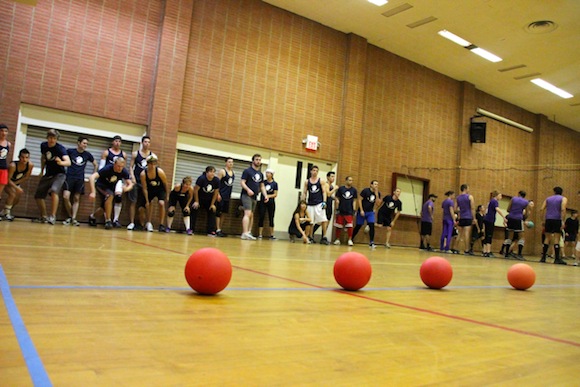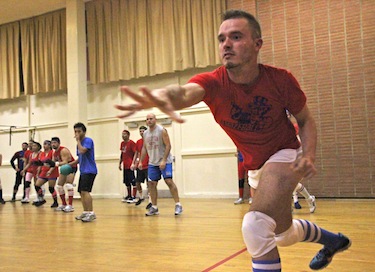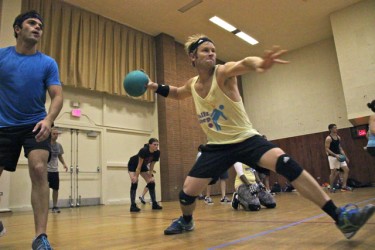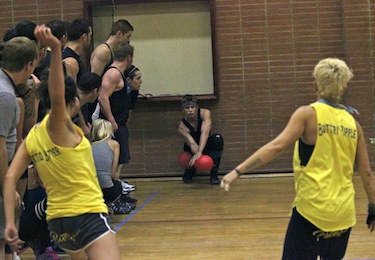
Amanda Sayers first delved into the dodgeball world as a student studying anthropology at USC. Studying the league for a class got her hooked, and she soon joined up.
This year, she is a first-year captain on the “Dodgeball for Dummies” squad.
With Sayers’ help, we made sense of the four main dodgeball positions, and game terminology.
[hr]
Position guide
Catchers – Catchers need good hands and good hand-eye coordination. Many players think this position is the most important, because a catch creates a two-player swing: it gets the thrower out and allows a teammate to re-enter the game.
Yet, catchers are often forgotten, because they rarely have the ball in their hands.

Corners – Corners are the dodgeball pawns. They attack when beneficial, but often are a defensive, and sometimes sacrificial, buffer. They protect the more valuable pieces behind them. Each team has two corners who play near the outside edges of the court. They each have a ball they use for blocking, and sometimes they use it to scare opponents who creep up toward the center-line. Strong corners have the ability to peg throwers who expose an open area when throwing.
Snipers – As the name implies, snipers wait in the backline weeds. More than power, the position requires great timing and precision. Sniper attacks are limited. They hang in the back waiting for someone to become vulnerable. Snipers often try to obscure the fact that they have the ball. Sometimes they throw from behind, around or between blockers (catchers).
Throwers – These players get to handle the most balls. Baseball and softball backgrounds are a plus. A strong arm is needed. Throwers often go forward toward the center-line, but become open to a counterattack.
[hr]
Important terms:

attack line– The center or half-court line, which is the furthest either team can attack from.
ball control – Keeping the majority of the seven balls on your side of the court, and systematically attacking.
buddy up – Offense: Synchronized throwing with one or more teammates. Defense: When catchers pair up with snipers or throwers to block the opposition, and to protect teammates from direct counterattacks.
deflection – When the ball ricochets off a ball or player. Offense: Deflections can be a major weapon because they can get multiple players out on one throw. Defense: Players often use a ball to deflect another up, hoping a teammate will make the catch.
fault– Any action other than being hit that results in a player being ruled out, including stepping over the attack line, going out of bounds or repeatedly making high throws.
headshot – A thrown ball that hits a player anywhere above the neck. If the player is standing, he/she is not out and the thrower is given a warning for high throws.
opening run – The initial run to get the balls at the attack line.
pump faking – An act done to fool the opposition into believing a ball is coming their direction.

suicide – Jumping over the attack line, and in effect sacrificing yourself to hit another player.
This season, the suicide has been ruled illegal in the WeHo Dodgeball league. Player Aaron Fox called the kamikaze attack “the most outrageous thing” he’s seen in the past. “I was just waiting for someone to die. I just thought that was crazy,” he said.
10-second count – An edict issued by the referees to the team holding a majority of the seven balls in play. They have 10 seconds to throw however many balls they hold more than the opposition. If a team does not comply with the count, they must give the opponent all of their balls.
